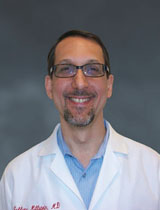Takeaway
As in physics, the answers are usually in plain sight. Listening to our patients with curiosity and humility will usually lead to understanding.

Connecting with Patients | August 14, 2019 | 3 min read
By Jeffrey Millstein, MD, Penn Medicine
On the surface, Sam’s issue seemed straightforward. He had persistent left flank and lower back pain, which was worse with bending and twisting motions. At age 55, he was still active, working out on a weight circuit three times a week along with some weekend cycling. He did not have fever, weight loss, or genitourinary symptoms. I explained that this had all the hallmarks of a muscular strain, and that heat, ibuprofen, and a short break from the gym could help.
When he returned the following week, things were no better. We moved along with some lab tests and imaging, which again failed to disclose a clear diagnosis. At our next meeting, I told Sam that I was unsure about the cause of his symptoms, and the exam room air became dense with our mutual frustration. I considered a referral, but knew I would have been firing blindly at my specialist colleagues for an answer.
Instead, I returned to the history and tried to take in Sam’s story in a more open-ended fashion, nodding my encouragement and empathizing with his vexation and dismay. I sensed from his posture and expression that he may have a concern that was difficult to disclose. I asked him what he was most worried could be wrong, and he told me about a close friend, similar in age, who was battling renal cancer. The symptoms were “just like mine,” he said.
Peeling off the surface
Finally, I had peeled off the surface issue which, if it stood alone, would probably respond to textbook treatment, and exposed a more complex concern that would almost certainly not. It required that I do something that feels unnatural – delve into uncertainty, explore a personal story laced with worry, imagination, and undistilled pieces of information. Herein lay Sam’s unique thoughts and patterns that I could not have predicted. They contained the real key to helping him.
Physics connections
Earlier this year, I listened intently to a family friend and physics enthusiast casually review some of the essential breakthroughs in quantum mechanics. He explained how the nature of subatomic components reveals behaviors that illuminate our experience in the macroscopic world. As he said this, my thoughts turned to Sam. I considered how in his case and others, as with science, the more closely and objectively I observed, the more likely an elegant although unexpected truth becomes clear.
The assumption that science is exact
This belies the assumption many of us have that science is predictable and exact. Illnesses, like physical properties, are laced with uncertainty, and do not always follow the predicted pathways. Patients who are suffering due to an unknown reason are often referred into an abyss of subspecialists, or told “nothing is wrong,” or “don’t worry, you will be fine.” This gets the clinician off the hook, but the patient continues to suffer. In Sam’s case, a simple pain was a conduit to a discussion about concern for a close friend, and his own fear of renal cancer. Unexpected, it does not fit the textbook teaching, is inconsistent with my prior experience, but is, nonetheless, my patient’s story which I can truly hear if I choose to receive it unconditionally.
The reality of doubt and uncertainty in science and medicine
Some could say that listening to stories and embracing uncertainty are relegated to the “art” of medicine, as opposed to science. My friend explained very clearly though, that doubt and uncertainty are equally integral to science and scientific discovery. They are the true drivers of scientific progress and, as with the medical interview, need to be packaged with the application of knowledge and experience, and wrapped with wonder. Even when this still doesn’t lead to a clear diagnosis, my patient has been given the opportunity to express their true concern, which, in Sam’s case, was in itself therapeutic.
Curiosity, humility, and listening
As in the physical world, most of the answers to puzzles are sitting right before us in the form of patients like Sam, who are looking for permission to tell us what lies below the surface in their unique experience. All we have to do is offer curiosity and humility, and then just listen and take it all in.

